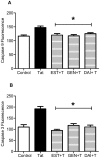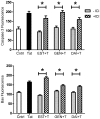Soy isoflavones genistein and daidzein exert anti-apoptotic actions via a selective ER-mediated mechanism in neurons following HIV-1 Tat(1-86) exposure
- PMID: 22629415
- PMCID: PMC3358258
- DOI: 10.1371/journal.pone.0037540
Soy isoflavones genistein and daidzein exert anti-apoptotic actions via a selective ER-mediated mechanism in neurons following HIV-1 Tat(1-86) exposure
Abstract
Background: HIV-1 viral protein Tat partially mediates the neural dysfunction and neuronal cell death associated with HIV-1 induced neurodegeneration and neurocognitive disorders. Soy isoflavones provide protection against various neurotoxic insults to maintain neuronal function and thus help preserve neurocognitive capacity.
Methodology/principal findings: We demonstrate in primary cortical cell cultures that 17β-estradiol or isoflavones (genistein or daidzein) attenuate Tat(1-86)-induced expression of apoptotic proteins and subsequent cell death. Exposure of cultured neurons to the estrogen receptor antagonist ICI 182,780 abolished the anti-apoptotic actions of isoflavones. Use of ERα or ERβ specific antagonists determined the involvement of both ER isoforms in genistein and daidzein inhibition of caspase activity; ERβ selectively mediated downregulation of mitochondrial pro-apoptotic protein Bax. The findings suggest soy isoflavones effectively diminished HIV-1 Tat-induced apoptotic signaling.
Conclusions/significance: Collectively, our results suggest that soy isoflavones represent an adjunctive therapeutic option with combination anti-retroviral therapy (cART) to preserve neuronal functioning and sustain neurocognitive abilities of HIV-1 infected persons.
Conflict of interest statement
Figures





References
-
- Liner J, Hall CD, Robertson KR. Effects of antiretroviral therapy on cognitive impairment. Curr HIV/AIDS Rep. 2008;5:64–71. - PubMed
-
- Boissé L, Gill MJ, Power C. HIV infection of the central nervous system: clinical features and neuropathogenesis. Neurol Clin. 2008;26:799–819. - PubMed
-
- Gartner S. HIV infection and dementia. Science. 2000;287:602–604. - PubMed
Publication types
MeSH terms
Substances
Grants and funding
LinkOut - more resources
Full Text Sources
Research Materials

